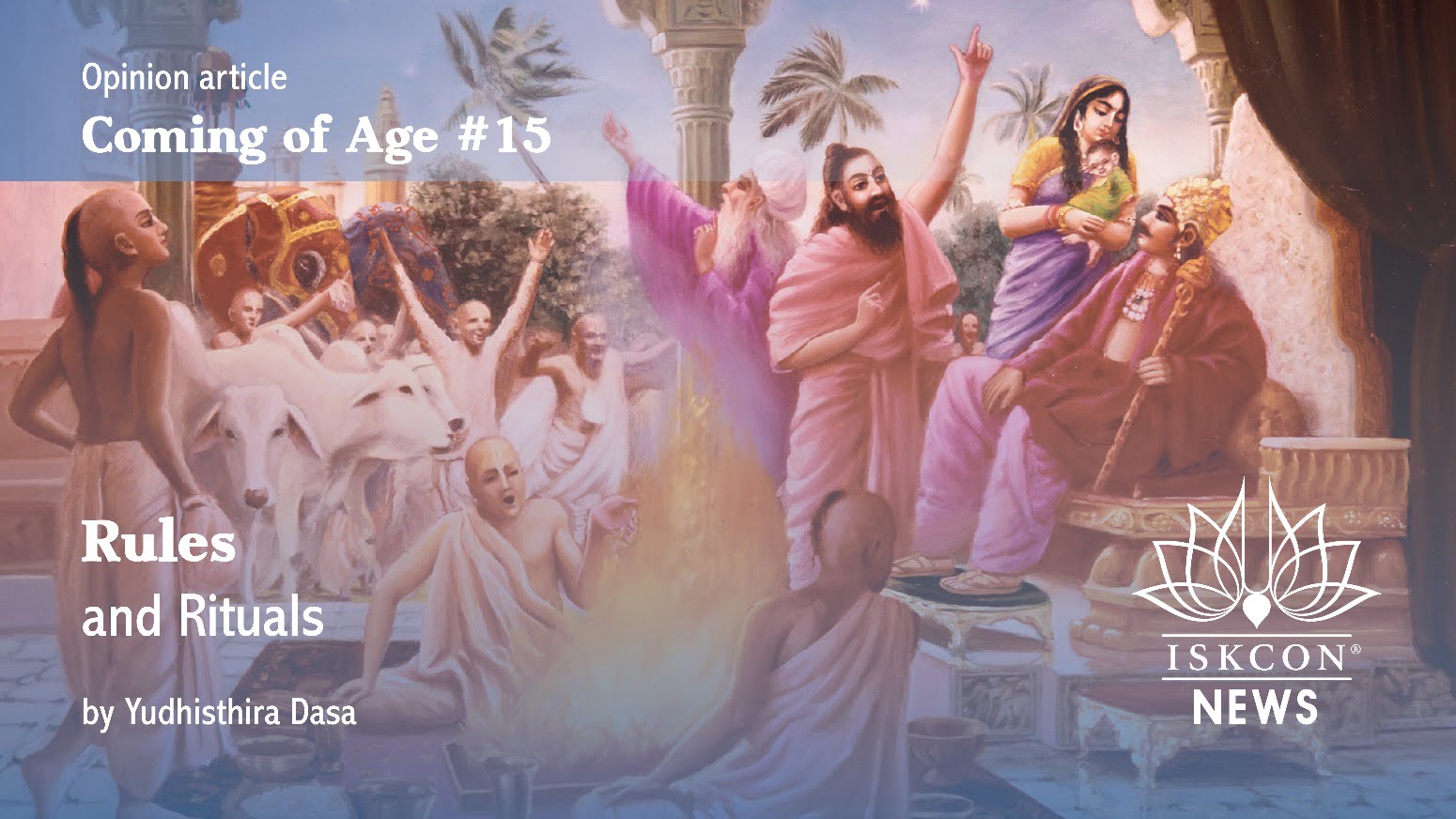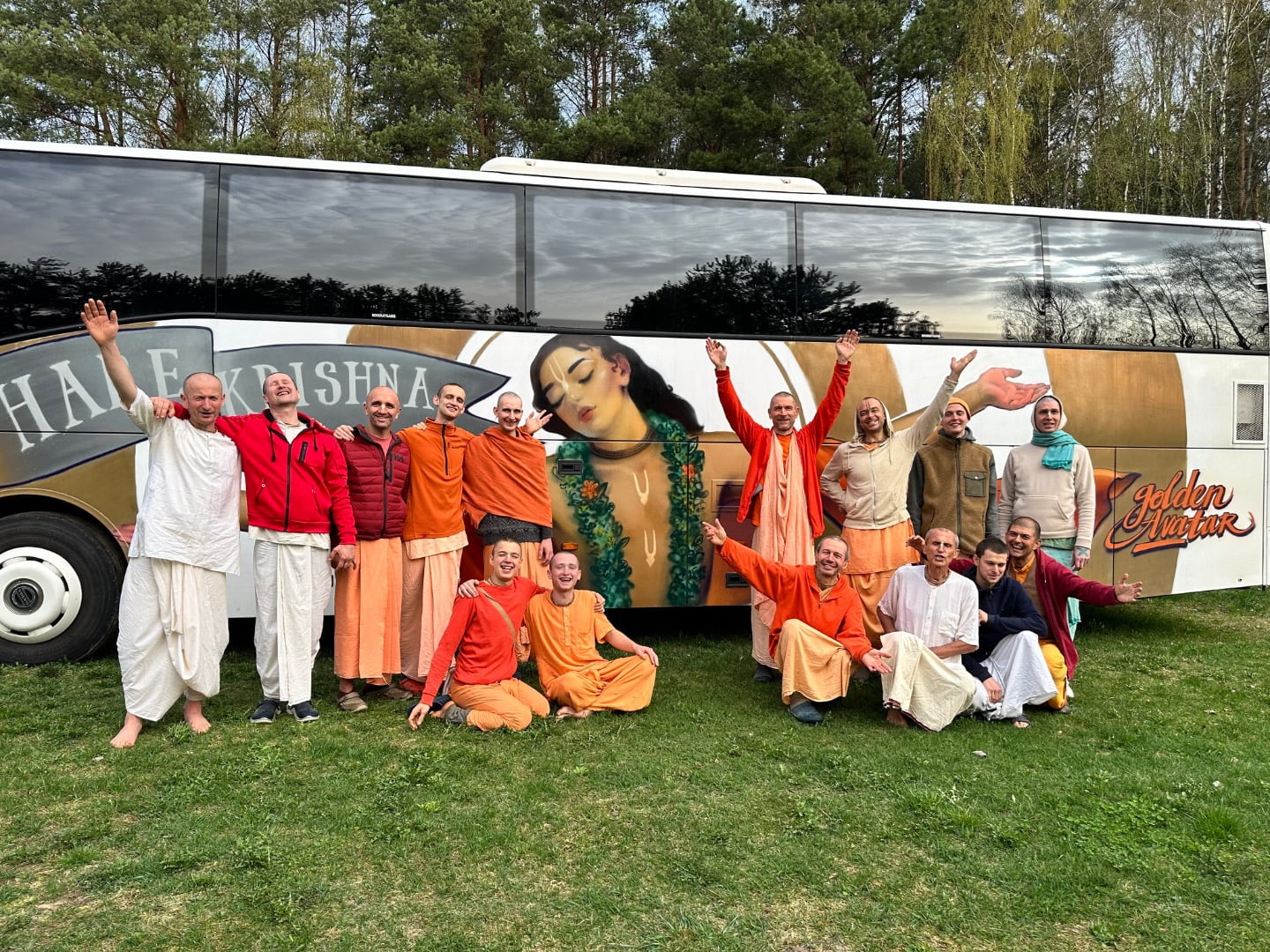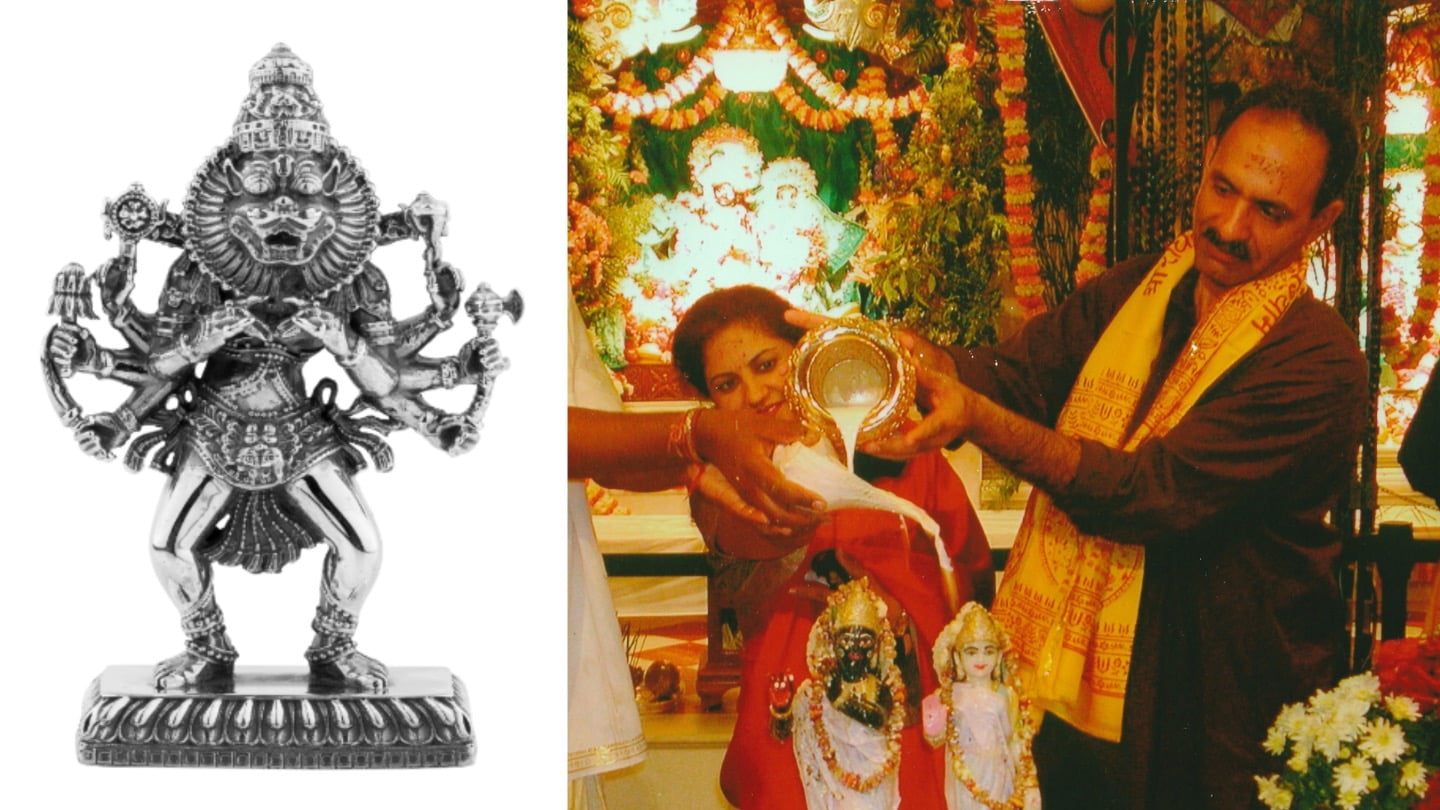Inking With the Supreme: Are Tattoos Taboo?
By Madhava Smullen | Aug 09, 2008

Images courtesy of Back to Godhead magazine. Used with permission.
Tattoos have been inked permanently into modern culture. Walk down any busy city street and you’ll spot a vast number of tattooees, ranging all the way from the young female professional with a butterfly on her shoulder blade to the wild punk rocker with hardly any space left for his white skin to shine. For some reason, having an unremovable image of a two-headed dragon eating its own face sprawled across their chest until their dying breath is an idea that appeals to a lot of people. National Geographic News reported in April 2000 that fifteen per cent of Americans were tattooed. That’s around forty million people.
Now, surely a Hare Krsna devotee would be the last person you’d expect to see among those forty million, right?
Wrong. The fact is that many devotees sport tattoos, and their number is increasing. Is this a purely whimsical fad, or do our ancient traditions and scriptures hold any foundations for devotional tattooing?
A Burning Impression
He has to pause for breath.
“On my back, I’ve got two of the greatest warriors in Vedic history–Arjuna on one side and Parasurama on the other. They’re complemented by a fire sacrifice pit in between them, and they protect my back from any misfortune. Next, on my chest are two aspects of Krsna’s beauty–Lord Krsna Himself and His dwarf incarnation, Vamana.”
Of course, Caturatma concedes, the modern incarnation of tattooing wasn’t around during or before the birth of Gaudiya Vaisnavism, but there are close parallels. In the Prameya Ratnavali, the eighteenth-century Vaisnava commentator Baladeva Vidyabhusana cites five purificatory processes (panca-samskara) that, along with spiritual initiation, bring one direct perception of Lord Krsna: austerity, wearing tilaka, performing sacrifices, accepting a new name at initiation, and chanting mantras glorifying the Lord.
Baladeva’s elaboration is surprising: “In this verse, the word austerity means to accept the branded marks of Lord Visnu: the disc, lotus, conch, and mace”–the very images Caturatma has tattooed on his arms.
Like tattooing, branding is permanent, and yes, very painful.
A tradition that goes back to at least A.D. 1017, it’s still practiced today by followers of both Madhvacarya and Ramanujacarya, mainly in the South Indian states of Karnataka, Tamil Nadu, Kerala, and Andhra Pradesh. What’s more, for Sri Vaisnavas, Ramanuja’s followers, it’s an essential part of the initiation process.
Picture this:
It’s morning, and the air is cool. As the sun rises behind you and the birds start to twitter, your heart beats fast but you sit quietly, staring at the blazing sacrificial pit in front of you. A married priest performs the fire ceremony. Offering oblations, he invokes the ayudha-devatas, personified forms of Lord Visnu’s sacred weapons.
Metal stamps in the traditional shape of each weapon are then attached to metal poles and held within the dancing flames. After some time, your guru takes them and taps them on a plate. You watch, knowing that this is to make sure no loose pieces of hot charcoal come off on your skin. Finally, he begins to chant the mantra for Sudarsana, Lord Visnu’s discus. It’s time. You tense. You feel the red hot brand press against your right shoulder, burning, stinging. Then the Pancajanya mantra is chanted, and the symbol of Visnu’s conchshell is branded on your left shoulder. You sigh. It’s over.
You are now ready for the rest of your initiation ceremony.
Fortunately for us, Caitanya Mahaprabhu and the acaryas in His line have recommended that one use tilaka clay instead of branding to draw Visnu’s symbols on the body. So if you’re on the list for spiritual initiation, no need to scream and run–no Gaudiya Vaisnava guru will try to press a red-hot iron pole against your arm during the ceremony.
The Sacred Clay Connection
“Persons whose bodies are marked with tilaka, symbolizing the conchshell, wheel, club, and lotus… even seen once, can help the seer be relieved from all sinful activities.”
Internal Matters
Srila Bhaktivinoda Thakura certainly had an opinion.
In his 1885 essay Pancha Samskara: The Process of Initiation, he discusses the five purificatory processes from Prameya Ratnavali mentioned earlier in this article, two of which are tapa (defined by Baladeva Vidyabhusana as branding) and wearing tilaka markings.
Yes, he acknowledges them as prescribed ways to sanctify oneself so that one’s true spiritual nature can develop. But far more forcefully, he condemns being concerned only with the external: “Tapa applies not only to the body, but also to the mind and the soul. If it is only physical, in the form of branding or stamping, then tapa has not actually taken place and religious practice becomes hypocritical.”
He continues emphasizing the hollowness of such an approach: “Externally the student looks good, but internally there is nothing. The symbols of divine conch, disc, and the name of Hari [Krsna] mark the body. The tongue utters the name of Hari, and worship of salagrama-sila or the deity with mantra is performed, but the student is addicted to endless sinful practices.”
Her single tattoo, the words Sri Sri Radha-Krsna in Sanskrit Devanagari script beneath a lotus flower, reflects her “less is more” outlook.
“Samosas are delicious, but if you eat four hundred of them, you get sick. So if something material like a tattoo helps you to remember Krishna, it can be used in Krishna’s service, but if it’s used in excess, then it becomes an end in itself.”
Laksmimani says her tattoo, a birthday present from her daughter, does its job.
“I wanted something that had Krsna on it so that I would never be able to forget Him, so that He’d be with me all the time. And that’s what happened. I guess it’s just part of me now.”
What’s more, her tattoo doesn’t benefit her alone.
“People approach me constantly to ask me what it is and what it says, because it’s in Sanskrit. It’s a great excuse to tell them about Krsna.”
Caturatma Dasa has had the same experience.
“Once I was doing some yardwork at a devotee friend’s house. Since it was a hot summer’s day, I wasn’t wearing a shirt, and all my tattoos were on full display. Suddenly, a delivery van pulled up, and as it came closer, I saw the wording on its side: ‘Bill’s Home Delivery Shrimp and Fresh-Cut Meats. Wholesale to your door.’
” ‘Oh, oh,’ I thought, ‘He doesn’t realize where he’s just pulled into.’ So I walked over to the car, and the passenger window came down. It was an old black guy who had obviously lived in the area for years. ‘How you doin’ there, sir,’ he says. ‘I’m just going around door to door selling these shr–“
Caturatma freezes dramatically.
“Suddenly the guy stops in mid-sentence. ‘Oh,’ he says, ‘I can see by your tattoos you’re not gonna be interested in what I’m selling. I might as well just take my truck on down the road to the next house. You’re one of those Hare Krsna people, and I know you guys are vegetarian and don’t eat meat.'”
As Caitanya Mahaprabhu once said, “A Vaisnava is he who, when seen, reminds one of Krsna.”
So. Let’s say you’ve thought about it. Let’s say you’ve decided that getting a Krsna conscious tattoo is a bona fide way to express your devotion, to remind yourself and others of Krsna.
What next?
Come into my Tattoo Parlour
“Whatever tattoo you’re getting, just make sure it’s something you’ll be happy living with. Because it’s gonna stay with your body longer than you will.”
When it comes to artwork, he is partial to that of Gujarati artist B.G. Sharma.
“His style practically already looks like tattoos. Everything has an outline, and his shading is similar to the way I’d shade or color a tattoo. It’s really easy to replicate.”
“I have the maha-mantra tattooed in Bengali all over both of my arms, which is unique and completely unfamiliar to the average person. When people see it, they never fail to ask what it is.”
This happens so often that Kalpa keeps a stack of Srila Prabhupada’s small books handy at all times.
“I’ll tell clients what my tattoo is and what it means. Then if they seem interested, I’ll explain the maha-mantra and a little about Krsna consciousness. And eventually, if their interest deepens, I’ll hand them a book. I try to build a rapport with people. You can’t just hit them with everything all at once.”
Recent times, however, have brought on a new experience: Sometimes Kalpavrksa finds himself asking people about their Vedic tattoos.
“Modern Western tattooing has always had a heavy Asian influence, mainly from the two-hundred-year-old Japanese tradition. But in the past ten to twelve years, there’s been a huge rush of interest in Indian imagery. Yoga is really big these days, and students are often influenced to get tattoos of mantras and various symbols like the om sign. One girl walked into my tattoo shop sporting tattoos of different yogic asanas.“
There are more signs of this Vedic tattoo invasion everywhere. Pick up any modern tattoo magazine released within the past five to ten years, and you’ll find either an image directly related to Krsna, or something from the Vedic paradigm. The goddesses Kali, Durga, and Laksmi flood tattoo parlours, as does Lord Siva. Lord Nrsimhadeva rears His fearsome head from the pages of tattoo magazines, and the friendly, easily identifiable face of Lord Jagannatha becomes more and more popular. Tattoo stores across the United States keep their own copy of the Krsna Art book. Krsna, in the form of art, is gradually infiltrating the tattoo-wearing public.
But for now, He still remains most popular with those who hold Him deep within their hearts.














